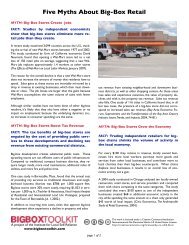Building Healthy Soils with Compost to Protect Watersheds
Building Healthy Soils with Compost to Protect Watersheds
Building Healthy Soils with Compost to Protect Watersheds
Create successful ePaper yourself
Turn your PDF publications into a flip-book with our unique Google optimized e-Paper software.
Top: Native soil and vegetation<br />
absorb almost all the rain that falls.<br />
Bot<strong>to</strong>m: Disturbed Soil. Urban<br />
development typically strips <strong>to</strong>psoil<br />
and compacts subsoils; rain then<br />
rushes off carrying pollutants in<strong>to</strong> the<br />
nearest water body. <strong>Protect</strong>ing soils<br />
and res<strong>to</strong>ring them <strong>with</strong> compost<br />
helps res<strong>to</strong>re soil functions.<br />
Images:<br />
Washing<strong>to</strong>n Organics Recycling<br />
Council <br />
range of pH than soils <strong>with</strong>out compost. 32<br />
Amending soil <strong>with</strong> compost creates a <br />
controlled, slow-‐release of phosphorous, <br />
potassium, sulfur and various other <br />
“micronutrients” critical <strong>to</strong> plant survival. <br />
These nutrients are also less likely <strong>to</strong> be <br />
lost through leaching as the stable organic <br />
matter in compost steadily allows plants <br />
<strong>to</strong> take what they need. 33 This offers low-maintenance<br />
attractive landscapes for <br />
home and property owners while <br />
reducing polluted runoff. In sum, an <br />
active sub-‐soil food web and reduced soil <br />
compaction create an overall healthy <br />
ecosystem, resulting in fewer required <br />
chemicals. 34 <br />
Benefit 5: Improved Soil Quality<br />
and Structure – <strong>Compost</strong>’s organic <br />
matter is the catalyst for the overall <br />
health of the entire soil ecosystem. <br />
Organic matter can be considered the <br />
soil’s fuel source, as it feeds billions of <br />
microorganisms. This microbial process <br />
allows for s<strong>to</strong>rmwater infiltration, <br />
drainage, and moisture-‐holding capacity <br />
and a strong, stable soil structure. 35 These <br />
passageways and a higher bulk density <br />
also allow plant roots <strong>to</strong> establish and <br />
expand. 36 This is particularly important for <br />
disturbed and compacted soils where <br />
compost amendment rejuvenates <br />
degraded soils <strong>to</strong> native-‐like conditions, <br />
providing food and shelter for beneficial <br />
organisms, and “restarting the soil <br />
ecosystem.” 37 Because soil organic matter <br />
consists of 10 <strong>to</strong> 1,000 times more water <br />
and nutrients than soil minerals, the <br />
many microbes and organisms can <br />
thrive. 38 In addition, compost makes the <br />
soil more fertile for plant growth by <br />
controlling pH levels, increasing buffering <br />
capacity against pH change. Research also <br />
shows that the type of organisms found in <br />
compost can curtail soil-‐borne diseases <br />
and plant pathogens like pythium and <br />
fusarium as well as nema<strong>to</strong>des. 39<br />
Benefit 6: Reduced Costs – Amending <br />
soils <strong>with</strong> compost produces significant <br />
cost savings. A recent study indicated that <br />
under a 3-‐inch/24-‐hour period s<strong>to</strong>rm, a <br />
typical 10-‐acre development <strong>with</strong> a <br />
compost blanket (i.e. a layer of loosely <br />
applied compost) would reduce runoff <br />
volume as compared <strong>to</strong> an impervious <br />
site and avoid $181,428 per year in water <br />
treatment costs. If the runoff was treated <br />
on-‐site <strong>with</strong> a s<strong>to</strong>rmwater management <br />
pond, the compost blanket application <br />
equates <strong>to</strong> a cost reduction of $697,800, <br />
avoiding the need for a larger pond <strong>to</strong> <br />
accommodate an increased volume of <br />
water. 40 Municipal government can <br />
realize “tax collection gains from <br />
increased land values and lower water <br />
treatment costs.” 41 Many other compost <br />
products can reduce the cost of erosion <br />
and overburdened s<strong>to</strong>rmwater <br />
management systems – a cost <strong>to</strong>taling <br />
$44 billion each year in America. 42 <br />
Benefit 7: Job Creation – <strong>Compost</strong>ing <br />
in Maryland sustains twice as many jobs <br />
on a per-‐<strong>to</strong>n basis as landfilling organic <br />
discards, but four times more than <br />
incineration. Using compost in green <br />
infrastructure such as <strong>to</strong> control soil <br />
erosion and reduce s<strong>to</strong>rmwater runoff <br />
sustains even more jobs. For every 10,000 <br />
<strong>to</strong>ns per year of material diverted from <br />
incineration <strong>to</strong> compost production and <br />
local use, nine times more jobs are <br />
created and across multiple industries. 43<br />
Filtrexx, the leading producer of compost-based<br />
erosion control and s<strong>to</strong>rmwater <br />
management systems, alone supports <br />
over 100 Filtrexx certified businesses. 44 In <br />
Texas, when the Department of <br />
Transportation specified compost for <br />
highway maintenance projects, it created <br />
the nation’s largest compost market, <br />
giving rise <strong>to</strong> an entire new industry of <br />
contrac<strong>to</strong>rs specializing in innovative <br />
methods <strong>to</strong> apply compost <strong>to</strong> roadsides. 45<br />
Portland Green Streets <br />
Portland, OR, street planters, curb <br />
extensions, and simple green strips <br />
in the medians along city streets: <br />
<br />
<br />
<br />
<br />
<br />
<br />
<br />
<br />
<br />
<br />
Reduce peak flow cost-effectively<br />
80+% <br />
Filter pollutants <br />
Recharge groundwater <br />
Rehabilitate soil <br />
Improve pedestrian safety <br />
Beautify neighborhoods <br />
Provide volume detention <strong>to</strong> <br />
handle most rain events <br />
Provide more space <strong>to</strong> plant <br />
trees <br />
Increase home values <br />
Alleviate urban “heat island” <br />
effect <br />
Source: David Elkin, landscape architect, <br />
GreenWorks, Portland, OR. <br />
www.sustainablecitynetwork.com <br />
Pho<strong>to</strong>: © City of Portland, courtesy Bureau of <br />
Environmental Services <br />
4 <strong>Building</strong> <strong>Healthy</strong> <strong>Soils</strong> <strong>with</strong> <strong>Compost</strong> <strong>to</strong> <strong>Protect</strong> <strong>Watersheds</strong>





